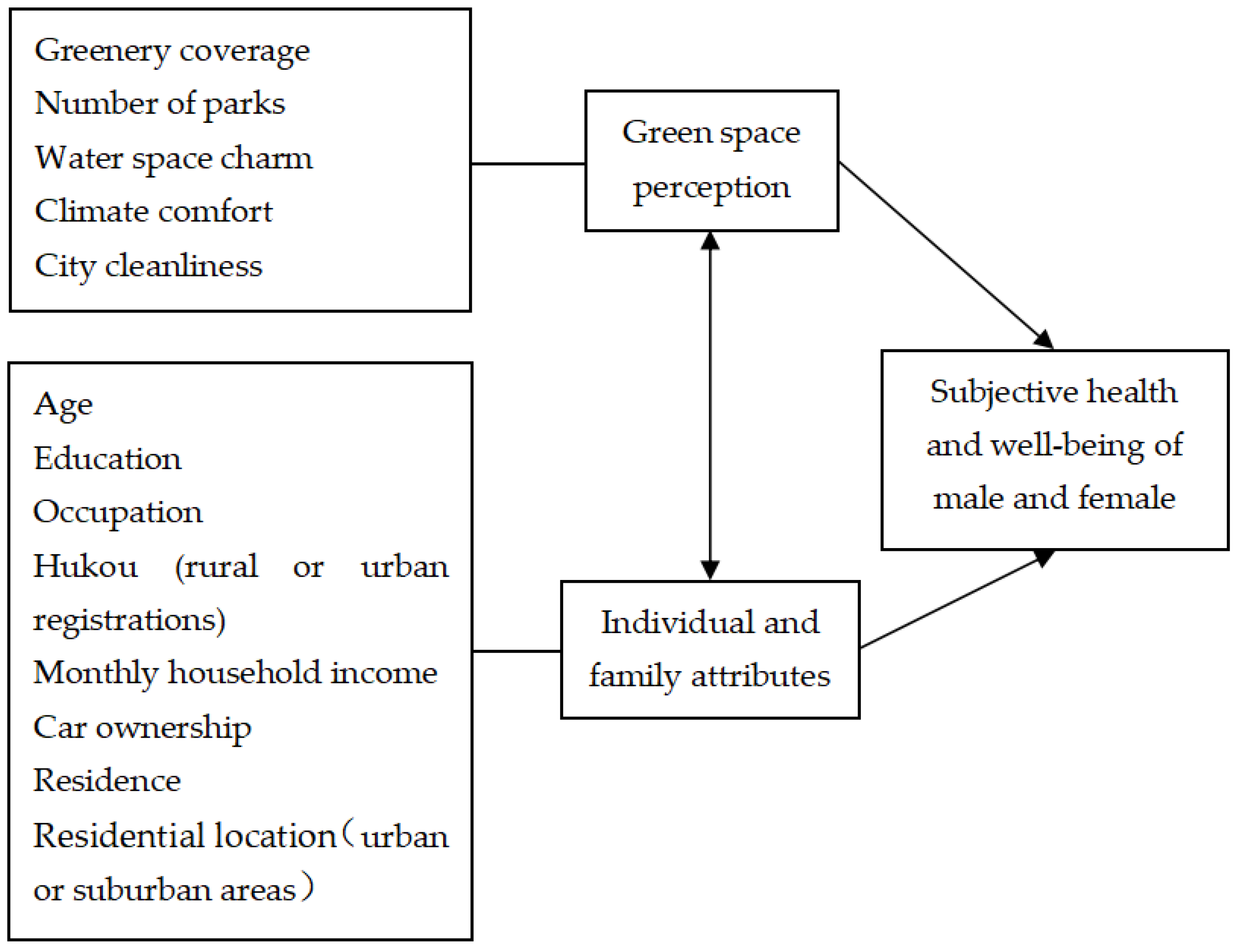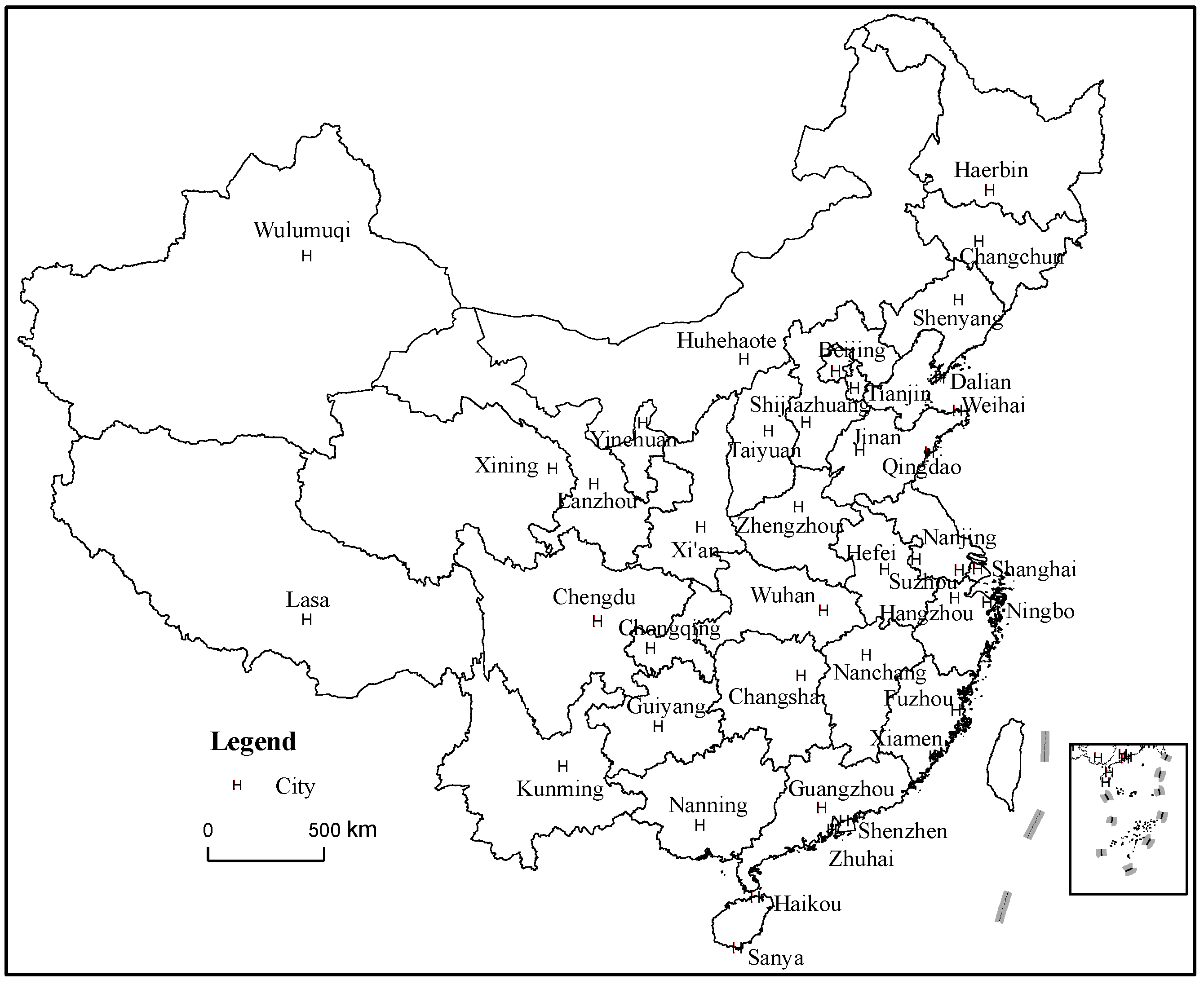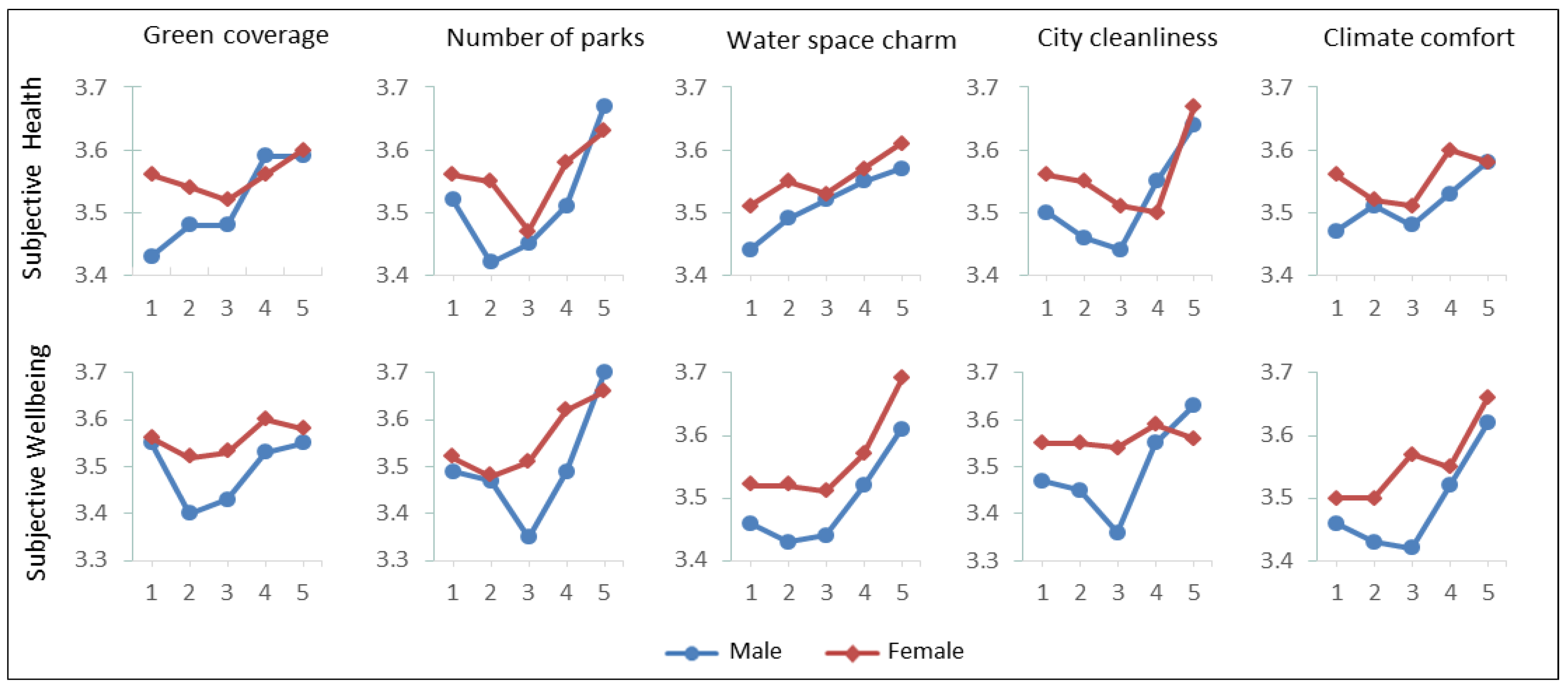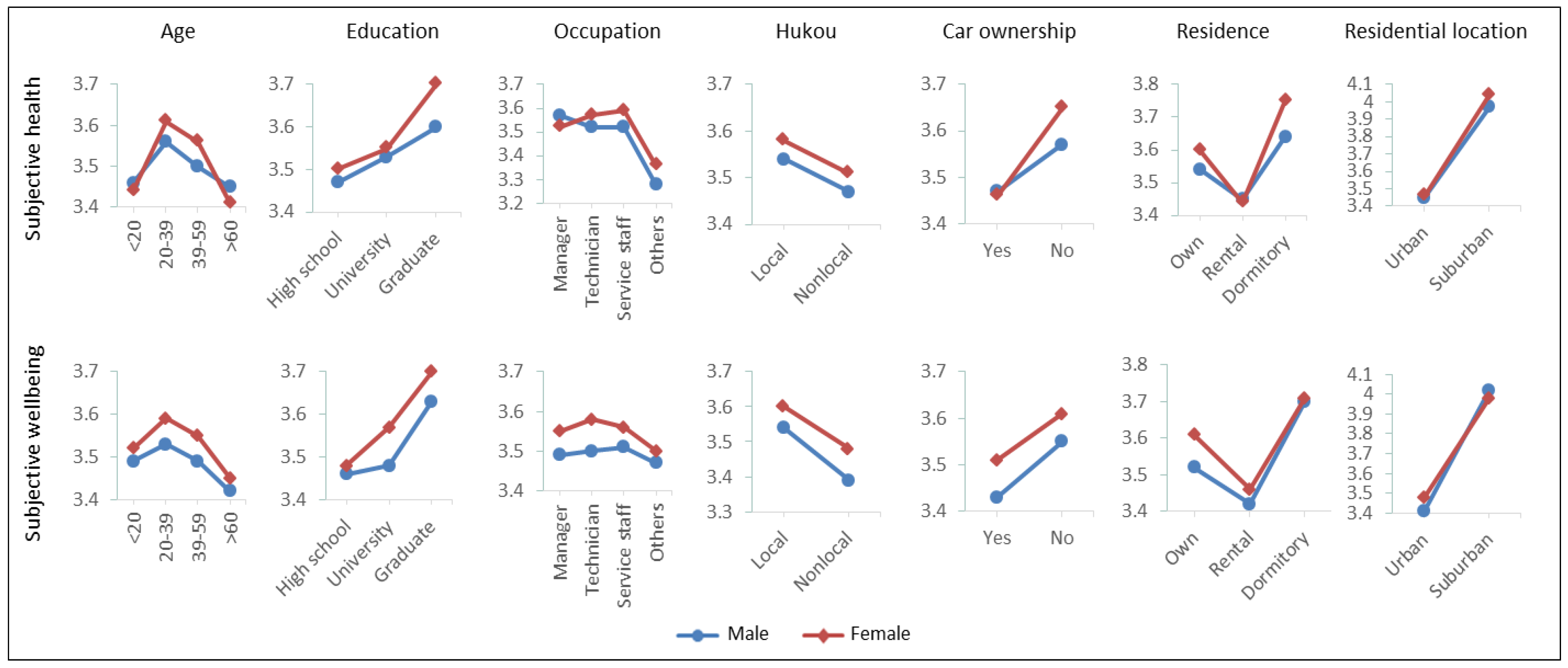Gender Disparity in Perceived Urban Green Space and Subjective Health and Well-Being in China: Implications for Sustainable Urban Greening
Abstract
1. Introduction
2. Methods
2.1. Study Design
2.2. Data Source and an Explanation of Variables
2.3. Statistical Method
3. Results
3.1. Variable Descriptive Statistics
3.2. Factor Detection Results
3.3. Risk Detection Results
3.4. Interaction Detection Results
4. Discussions
5. Limitations
6. Conclusions
Author Contributions
Funding
Acknowledgments
Conflicts of Interest
References
- Samuelsson, K.; Barthel, S.; Colding, J.; Macassa, G.; Giusti, M. Urban nature as a source of resilience during social distancing amidst the coronavirus pandemic. Landsc. Urban Plan. 2020. [Google Scholar] [CrossRef]
- Khan, O. Coronavirus Exposes How Riddled Britain is with Racial Inequality. The Guardian. 20 April 2020. Available online: https://www.theguardian.com/commentisfree/2020/apr/20/coronavirus-racial-inequality-uk-housing-employment-health-bame-covid-19 (accessed on 30 May 2020).
- Kondo, M.C.; Mueller, N.; Locke, D.; Roman, L.A.; Rojas-Rueda, D.; Schinasi, L.H.; Gascon, M.; Nieuwenhuijsen, M.J. Health impact assessment of Philadelphia’s 2025 tree canopy cover goals. Lancet Planet. Health 2020, 4, e149–e157. [Google Scholar] [CrossRef]
- Zhang, Z.; Liu, L. Environmental Health and Justice in a Chinese Environmental Model City. J. Environ. Health 2018, 80, E1–E9. [Google Scholar]
- Liu, L. The Dusty Lung Crisis in China: Rural-Urban Health Inequity as Social and Spatial Injustice. Soc. Sci. Med. 2019, 223, 218–228. [Google Scholar] [CrossRef]
- Hartig, T.; Mitchell, R.; De Vries, S.; Frumkin, H. Nature and Health. Annu. Rev. Public Health 2014, 35, 207–228. [Google Scholar] [CrossRef]
- Frumkin, H.; Bratman, G.N.; Breslow, S.J.; Cochran, B.; Kahn, P.H., Jr.; Lawler, J.J.; Levin, P.S.; Tandon, P.S.; Varanasi, U.; Wolf, K.L.; et al. Nature Contact and Human Health: A Research Agenda. Environ. Health Perspect. 2017, 125, 075001. [Google Scholar] [CrossRef]
- Kondo, M.C.; Fluehr, J.M.; McKeon, T.; Branas, C.C. Urban Green Space and Its Impact on Human Health. Int. J. Environ. Res. Public Health 2018, 15, 445. [Google Scholar] [CrossRef]
- Dzhambov, A.; Hartig, T.; Markevych, I.; Tilov, B.; Dimitrova, D. Urban residential green space and mental health in youth: Different approaches to testing multiple pathways yield different conclusions. Environ. Res. 2018, 160, 47–59. [Google Scholar] [CrossRef]
- Moore, T.; Kesten, J.; López-López, J.; Ijaz, S.; McAleenan, A.; Richards, A.; Gray, S.; Savović, J.; Audrey, S. The effects of changes to the built environment on the mental health and well-being of adults: Systematic review. Health Place 2018, 53, 237–257. [Google Scholar] [CrossRef]
- Norwood, M.F.; Lakhani, A.; Fullagar, S.; Maujean, A. A narrative and systematic review of the behavioral, cognitive and emotional effects of passive nature exposure on young people: Evidence for prescribing change. Landsc. Urban Plan. 2019, 189, 71–79. [Google Scholar] [CrossRef]
- Vujcic, M.; Tomicevic-Dubljevic, J.; Živojinović, I.; Tošković, O. Connection between urban green areas and visitors’ physical and mental well-being. Urban For. Urban Green. 2019, 40, 299–307. [Google Scholar] [CrossRef]
- Adhikari, B.; Mishra, S.; Dirks, K. Green space, health, and well-being: Considerations for South Asia. Lancet Planet. Health 2020, 4, e13543. [Google Scholar] [CrossRef]
- Jorgensen, A.; Hitchmough, J.; Calvert, T. Woodland spaces and edges: Their impact on perception of safety and preference. Landsc. Urban Plan. 2002, 60, 135–150. [Google Scholar] [CrossRef]
- Jiang, B.; Chang, C.-Y.; Sullivan, W.C. A dose of nature: Tree cover, stress reduction, and gender differences. Landsc. Urban Plan. 2014, 132, 26–36. [Google Scholar] [CrossRef]
- Bos, E.H.; Van Der Meulen, L.; Wichers, M.; Jeronimus, B.F. A Primrose Path? Moderating Effects of Age and Gender in the Association between Green Space and Mental Health. Int. J. Environ. Res. Public Health 2016, 13, 492. [Google Scholar] [CrossRef]
- Hinds, J.; Sparks, P.; Kruger, D.J.; Nesse, R.M. The Affective Quality of Human-Natural Environment Relationships. Evol. Psychol. 2011, 9, 451–469. [Google Scholar] [CrossRef]
- Thompson, C.J.; Boddy, K.; Stein, K.; Whear, R.; Barton, J.; Depledge, M.H. Does participating in physical activity in outdoor natural environments have a greater effect on physical and mental well-being than physical activity indoors? A systematic review. Environ. Sci. Technol. 2011, 45, 1761–1772. [Google Scholar] [CrossRef]
- Sang, Å.O.; Knez, I.; Gunnarsson, B.; Hedblom, M. The effects of naturalness, gender, and age on how urban green space is perceived and used. Urban For. Urban Green. 2016, 18, 268–276. [Google Scholar] [CrossRef]
- Richardson, E.A.; Mitchell, R. Gender differences in relationships between urban green space and health in the United Kingdom. Soc. Sci. Med. 2010, 71, 568–575. [Google Scholar] [CrossRef]
- Sander, H.A.; Ghosh, D.; Hodson, C.B. Varying age-gender associations between body mass index and urban green space. Urban For. Urban Green. 2017, 26, 1–10. [Google Scholar] [CrossRef] [PubMed]
- Jim, C.Y. Sustainable urban greening strategies for compact cities in developing and developed economies. Urban Ecosyst. 2013, 16, 741–761. [Google Scholar] [CrossRef]
- Nesbitt, L.; Meitner, M.J.; Girling, C.; Sheppard, S.R. Urban green equity on the ground: Practice-based models of urban green equity in three multicultural cities. Urban For. Urban Green. 2019, 44, 71–79. [Google Scholar] [CrossRef]
- UN (United Nations). Transforming Our World: The 2030 Agenda for Sustainable Development. 2015. Available online: https://sustainabledevelopment.un.org/content/documents/21252030%20Agenda%20for%20Sustainable%20Development%20web.pdf (accessed on 13 June 2020).
- UN. New Urban Agenda: Quito Declaration on Sustainable Cities and Human Settlements for All. 2016. Available online: http://nua.unhabitat.org/uploads/DraftOutcomeDocumentofHabitatIII (accessed on 30 May 2020).
- Barton, H.; Grant, M. A health map for the local human habitat. J. R. Soc. Promot. Health 2006, 126, 252–253. [Google Scholar] [CrossRef] [PubMed]
- Sallis, J.F.; Cervero, R.; Ascher, W.L.; Henderson, K.A.; Kraft, M.K.; Kerr, J. An Ecological Approach to Creating Active Living Communities. Annu. Rev. Public Health 2006, 27, 297–322. [Google Scholar] [CrossRef] [PubMed]
- Coutts, C.; Hahn, M. Green Infrastructure, Ecosystem Services, and Human Health. Int. J. Environ. Res. Public Health 2015, 12, 9768–9798. [Google Scholar] [CrossRef]
- Zhang, W.Z.; Yu, J.H.; Zhan, D.S.; Ma, R.F. A Study of Livable Cities in China; Science Press: Beijing, China, 2016. [Google Scholar]
- Wang, J.F.; Xu, C.D. Geodetector: Principle and prospective. Acta Geogr. Sinica 2017, 72, 116–134. [Google Scholar]
- Liu, Y.; Yang, R. Spatial characteristics and mechanisms of county level urbanization in China. Acta Geogr. Sinica 2012, 67, 1011–1020. [Google Scholar]
- Luo, W.; Jaroslaw, J.; Tomasz, S.; Wang, J.F.; Xu, C.D.; Cang, X.Z. Spatial association between dissection density and environmental factors over the entire conterminous United States. Geophys. Res. Lett. 2015, 43, 692–700. [Google Scholar] [CrossRef]
- Lou, C.-R.; Liu, H.; Li, Y. Socioeconomic Drivers of PM2.5 in the Accumulation Phase of Air Pollution Episodes in the Yangtze River Delta of China. Int. J. Environ. Res. Public Health 2016, 13, 928. [Google Scholar] [CrossRef]
- Zhang, Y.; Zhang, K.; An, Z.; Yu, Y. Quantification of driving factors on NDVI in oasis-desert ecotone using geographical detector method. J. Mt. Sci. 2019, 16, 2615–2624. [Google Scholar] [CrossRef]
- Bai, L.; Jiang, L.; Yang, D.-Y.; Liu, Y.-B. Quantifying the spatial heterogeneity influences of natural and socioeconomic factors and their interactions on air pollution using the geographical detector method: A case study of the Yangtze River Economic Belt, China. J. Clean. Prod. 2019, 232, 692–704. [Google Scholar] [CrossRef]
- Ye, Y.S.; Qi, Q.W.; Jiang, L.L.; Zhang, A. Impact factors of grain output from farms in Heilongjiang reclamation area based on geographical detector. Geogr. Res. 2018, 37, 171–182. [Google Scholar]
- Zhan, D.S.; Zhang, W.Z.; Dang, Y.X.; Qi, W.; Liu, Q.Q. Urban livability perception of migrants in China and its effects on settlement intention. Prog. Geogr. 2017, 36, 1250–1259. [Google Scholar]
- Zhan, D.S.; Zhang, W.Z.; Yu, J.H.; Meng, B.; Dang, Y.X. Analysis of influencing mechanism of residents’ livability satisfaction in Beijing using geographical detector. Prog. Geogr. 2015, 34, 966–975. [Google Scholar]
- Ding, Y.; Cai, J.M.; Ren, Z.P.; Yang, Z.S. Spatial disparities of economic growth rate of China’s National-level ETDZs and their determinants based on geographical detector analysis. Prog. Geogr. 2014, 33, 658–666. [Google Scholar]
- Popham, F. Leisure time exercise and personal circumstances in the working age population: Longitudinal analysis of the British household panel survey. J. Epidemiol. Community Health 2006, 60, 270–274. [Google Scholar] [CrossRef]
- Cohen, D.A.; McKenzie, T.L.; Sehgal, A.; Williamson, S.; Golinelli, D.; Lurie, N. Contribution of Public Parks to Physical Activity. Am. J. Public Health 2007, 97, 509–514. [Google Scholar] [CrossRef]
- Hutchison, R. Women and the elderly in Chicago’s public parks. Leis. Sci. 1994, 16, 229–247. [Google Scholar] [CrossRef]
- O’Brien, E.A. Publics and woodlands in England: Well-being, local identity, social learning, conflict and management. Forestry 2005, 78, 321–336. [Google Scholar] [CrossRef]
- Foster, C.; Hillsdon, M.; Thorogood, M. Environmental perceptions and walking in English adults. J. Epidemiol. Community Health 2004, 58, 924–928. [Google Scholar] [CrossRef] [PubMed]
- ONS. Black People Four Times More Likely to Die from Coronavirus than Whites; Office of National Statistics: London, UK, 2020. Available online: https://www.ons.gov.uk/peoplepopulationandcommunity/birthsdeathsandmarriages/deaths/articles/coronavirusrelateddeathsbyethnicgroupenglandandwales/2march2020to10april2020 (accessed on 7 May 2020).
- Hillsdon, M.; Panter, J.; Foster, C.; Jones, A. The relationship between access and quality of urban green space with population physical activity. Public Health 2006, 120, 1127–1132. [Google Scholar] [CrossRef] [PubMed]
- Jones, A.P.; Hillsdon, M.; Coombes, E. Greenspace access, use, and physical activity: Understanding the effects of area deprivation. Prev. Med. 2009, 49, 500–505. [Google Scholar] [CrossRef] [PubMed]




| Variable | Male | Female | T |
|---|---|---|---|
| Subjective health | 3.52 | 3.55 | −1.821 * |
| Subjective well-being | 3.49 | 3.56 | −3.269 *** |
| Greenery coverage | 3.08 | 3.03 | 1.910 * |
| Number of parks | 3.07 | 3.05 | 0.742 |
| Water space charm | 3.03 | 3.01 | 0.651 |
| Climate comfort | 3.09 | 3.04 | 1.864 * |
| City cleanliness | 3.07 | 3.05 | 0.709 |
| Variable Type | Variable Name | Subjective Health | Subjective Well-Being | ||
|---|---|---|---|---|---|
| Male | Female | Male | Female | ||
| Green space perception factor | Water space charm | 0.041 *** | 0.028 * | 0.048 *** | 0.049 *** |
| Green coverage | 0.057 *** | 0.012 | 0.022 | 0.016 | |
| Number of parks | 0.055 *** | 0.022 | 0.057 *** | 0.055 *** | |
| Climate comfort | 0.029 ** | 0.017 | 0.054 *** | 0.047 *** | |
| City cleanliness | 0.053 *** | 0.018 | 0.056 *** | 0.008 | |
| Individual and family attributes | Age | −0.025 * | −0.027 * | −0.032 ** | −0.032 ** |
| Education | 0.031 ** | 0.044 *** | 0.028 * | 0.052 *** | |
| Occupation | −0.029 ** | −0.027 * | 0.021 | −0.027 * | |
| Hukou | −0.036 ** | −0.033 ** | −0.066 *** | −0.057 *** | |
| Monthly household income | −0.028 | 0.001 | −0.035 ** | 0.016 | |
| Car ownership | 0.052 *** | 0.090 *** | 0.055 *** | 0.047 *** | |
| Residence | −0.013 | −0.018 | −0.002 | −0.026 * | |
| Residential location | 0.172 *** | 0.203 *** | 0.195 *** | 0.177 *** | |
| Variable Type | Variable Name | Q of Health | Q of Well-Being | ||
|---|---|---|---|---|---|
| Male | Female | Male | Female | ||
| Green space perception factor | Water space charm | 0.18 | 0.11 | 0.36 *** | 0.37 *** |
| Green coverage | 0.39 *** | 0.06 | 0.38 *** | 0.09 | |
| Number of parks | 0.70 *** | 0.25 ** | 1.16 *** | 0.40 *** | |
| Climate comfort | 0.13 | 0.12 | 0.48 *** | 0.28 *** | |
| City cleanliness | 0.51 *** | 0.32 *** | 0.81 *** | 0.03 | |
| Individual and family attributes | Age | 0.42 ** | 0.50 *** | 0.51 *** | 0.52 *** |
| Education | 0.23 | 0.44 *** | 0.36 *** | 0.57 *** | |
| Occupation | 0.31 | 0.39 ** | 0.61 | 0.38 ** | |
| Hukou | 0.13 ** | 0.12 * | 0.44 *** | 0.32 *** | |
| Monthly household income | 0.3 | 0.13 | 0.3 | 0.16 | |
| Car ownership | 0.28 *** | 0.81 *** | 0.30 *** | 0.23 *** | |
| Residence | 0.35 | 0.87 *** | 1.01 *** | 0.74 ** | |
| Residential location | 2.97 *** | 4.10 *** | 3.80 *** | 3.13 *** | |
| Subjective Health | Ws | Gc | Np | Clc | Cic | A | E | O | H | Co | Re | Rl | |
|---|---|---|---|---|---|---|---|---|---|---|---|---|---|
| Ws | M | 0.2 | |||||||||||
| F | 0.1 | ||||||||||||
| Gc | M | 0.8 | 0.4 | ||||||||||
| F | 0.9 | 0.1 | |||||||||||
| Np | M | 1.2 | 1.4 | 0.7 | |||||||||
| F | 0.8 | 0.6 | 0.3 | ||||||||||
| Clc | M | 0.8 | 0.8 | 1.4 | 0.1 | ||||||||
| F | 0.5 | 0.7 | 1.0 | 0.1 | |||||||||
| Cic | M | 1.1 | 1.2 | 1.2 | 1.2 | 0.5 | |||||||
| F | 0.7 | 1.2 | 1.0 | 0.7 | 0.3 | ||||||||
| A | M | 1.1 | 1.4 | 1.5 | 1.2 | 1.6 | 0.4 | ||||||
| F | 1.0 | 1.0 | 1.3 | 1.4 | 1.4 | 0.5 | |||||||
| E | M | 1.0 | 1.2 | 1.4 | 0.7 | 1.4 | 0.8 | 0.2 | |||||
| F | 0.8 | 0.9 | 0.9 | 0.8 | 1.3 | 0.9 | 0.4 | ||||||
| O | M | 1.4 | 1.4 | 1.8 | 0.9 | 1.4 | 1.4 | 1.2 | 0.3 | ||||
| F | 1.4 | 1.0 | 1.0 | 1.4 | 1.1 | 1.5 | 1.5 | 0.4 | |||||
| H | M | 0.4 | 0.6 | 0.9 | 0.4 | 0.7 | 0.8 | 0.5 | 0.6 | 0.1 | |||
| F | 0.3 | 0.3 | 0.5 | 0.3 | 0.5 | 1.0 | 0.9 | 0.9 | 0.1 | ||||
| Co | M | 0.6 | 0.8 | 1.2 | 0.4 | 0.9 | 0.9 | 0.5 | 0.8 | 0.6 | 0.3 | ||
| F | 1.0 | 0.9 | 1.3 | 1.0 | 1.2 | 1.6 | 1.6 | 1.4 | 0.9 | 0.8 | |||
| Re | M | 0.9 | 1.1 | 1.4 | 0.9 | 1.4 | 1.3 | 1.3 | 1.3 | 0.7 | 0.8 | 0.4 | |
| F | 1.3 | 1.3 | 1.5 | 1.3 | 1.7 | 2.1 | 1.8 | 2.1 | 1.3 | 1.9 | 0.9 | ||
| Rl | M | 3.2 | 3.5 | 3.8 | 3.2 | 3.6 | 3.1 | 3.2 | 3.2 | 3.0 | 3.1 | 3.0 | 3.0 |
| F | 4.3 | 4.4 | 4.4 | 4.4 | 4.5 | 4.3 | 4.4 | 4.3 | 4.2 | 4.2 | 4.2 | 4.1 | |
| Subjective Well-Being | Ws | Gc | Np | Clc | Cic | A | E | O | H | Co | Re | Rl | |
|---|---|---|---|---|---|---|---|---|---|---|---|---|---|
| Ws | M | 0.4 | |||||||||||
| F | 0.4 | ||||||||||||
| Gc | M | 1.5 | 0.4 | ||||||||||
| F | 0.8 | 0.1 | |||||||||||
| Np | M | 1.7 | 2.2 | 1.2 | |||||||||
| F | 1.2 | 0.8 | 0.4 | ||||||||||
| Clc | M | 1.7 | 1.5 | 1.9 | 0.5 | ||||||||
| F | 1.1 | 1.0 | 1.1 | 0.3 | |||||||||
| Cic | M | 1.6 | 1.6 | 2.1 | 1.6 | 0.8 | |||||||
| F | 1.1 | 0.9 | 0.8 | 0.7 | 0.4 | ||||||||
| A | M | 1.7 | 1.9 | 2.1 | 1.7 | 2.2 | 0.5 | ||||||
| F | 1.6 | 1.2 | 1.2 | 1.2 | 1.0 | 0.5 | |||||||
| E | M | 1.2 | 1.4 | 2.0 | 1.5 | 1.9 | 1.2 | 0.4 | |||||
| F | 1.3 | 1.1 | 1.4 | 1.2 | 1.2 | 1.2 | 0.6 | ||||||
| O | M | 1.9 | 1.7 | 2.4 | 1.8 | 2.1 | 1.9 | 2.1 | 0.6 | ||||
| F | 1.1 | 1.0 | 1.3 | 1.4 | 0.9 | 1.2 | 1.5 | 0.4 | |||||
| H | M | 1.1 | 1.3 | 1.7 | 1.1 | 1.4 | 1.2 | 1.0 | 1.2 | 0.4 | |||
| F | 0.8 | 0.6 | 0.8 | 0.8 | 0.4 | 1.3 | 1.3 | 0.8 | 0.3 | ||||
| Co | M | 0.9 | 0.7 | 1.6 | 1.0 | 1.3 | 1.0 | 0.8 | 1.3 | 1.2 | 0.3 | ||
| F | 0.7 | 0.4 | 0.9 | 0.7 | 0.4 | 1.3 | 1.1 | 0.8 | 0.7 | 0.2 | |||
| Re | M | 1.6 | 2.1 | 2.6 | 2.0 | 2.5 | 2.8 | 1.9 | 2.2 | 1.6 | 1.5 | 1.0 | |
| F | 1.9 | 1.2 | 1.4 | 1.5 | 1.1 | 1.7 | 1.5 | 1.8 | 1.1 | 1.1 | 0.7 | ||
| Rl | M | 4.2 | 4.1 | 4.9 | 4.3 | 4.7 | 4.1 | 4.0 | 4.3 | 3.8 | 3.9 | 4.2 | 3.8 |
| F | 3.6 | 3.3 | 3.7 | 3.5 | 3.2 | 3.3 | 3.3 | 3.4 | 3.2 | 3.2 | 3.3 | 3.1 | |
Publisher’s Note: MDPI stays neutral with regard to jurisdictional claims in published maps and institutional affiliations. |
© 2020 by the authors. Licensee MDPI, Basel, Switzerland. This article is an open access article distributed under the terms and conditions of the Creative Commons Attribution (CC BY) license (http://creativecommons.org/licenses/by/4.0/).
Share and Cite
Li, X.; Liu, L.; Zhang, Z.; Zhang, W.; Liu, D.; Feng, Y. Gender Disparity in Perceived Urban Green Space and Subjective Health and Well-Being in China: Implications for Sustainable Urban Greening. Sustainability 2020, 12, 10538. https://doi.org/10.3390/su122410538
Li X, Liu L, Zhang Z, Zhang W, Liu D, Feng Y. Gender Disparity in Perceived Urban Green Space and Subjective Health and Well-Being in China: Implications for Sustainable Urban Greening. Sustainability. 2020; 12(24):10538. https://doi.org/10.3390/su122410538
Chicago/Turabian StyleLi, Xueli, Lee Liu, Zhenguo Zhang, Wenzhong Zhang, Dazhi Liu, and Yafen Feng. 2020. "Gender Disparity in Perceived Urban Green Space and Subjective Health and Well-Being in China: Implications for Sustainable Urban Greening" Sustainability 12, no. 24: 10538. https://doi.org/10.3390/su122410538
APA StyleLi, X., Liu, L., Zhang, Z., Zhang, W., Liu, D., & Feng, Y. (2020). Gender Disparity in Perceived Urban Green Space and Subjective Health and Well-Being in China: Implications for Sustainable Urban Greening. Sustainability, 12(24), 10538. https://doi.org/10.3390/su122410538




